“I feel tremendous guilt.
The short-term, dopamine-driven feedback loops that we have created are destroying how society works.”
Admitted Chamath Palihapitiya, former Vice President of User Growth at Facebook, to an audience of Stanford students, while responding to a question about his involvement in exploiting consumer behaviour.
While there is nothing inherently addictive about smartphones themselves, the true drivers of our attachments to these devices are the hyper-social environments they provide – their sinful nature.
While there is nothing inherently addictive about smartphones themselves, the true drivers of our attachments to these devices are the hyper-social environments they provide – their sinful nature.
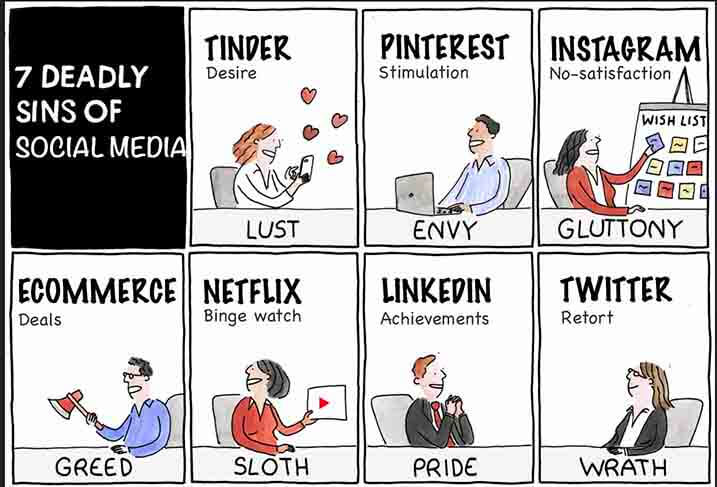
Social networks do best when they tap into one of the seven deadly sins. Facebook is ego. Zynga is sloth. LinkedIn is greed. ~ Reid Hoffman (co-founder of LinkedIn).
For those not familiar with the seven deadly sins, these sins are lust, gluttony, greed, sloth, wrath, envy, and pride. These sins are more than their stereotypes. For example, gluttony is not just about perpetually-consuming, but its apathy too i.e. person is never truly satisfied, losing interest and quickly getting bored. Social media is gluttony or gluttony is social media.
While the “sinfulness” of certain social networks may attract certain people to their platforms, many people stay because they have become inextricably habituated to the app. In many cases, a person becomes addicted.
Ubiquity of Addictions in “Never-Ending Now” Era
We are now all addicts to a degree.
Why? All indulgences are accessible today. We’re living in a time of unprecedented access to high-reward, high-dopamine stimuli: drugs, food, news, shopping, gaming, texting, gambling, binging…
Most important – “Endlessly and Mindlessly” scrolling on social media. You are what you consume. Instagram. TikTok. Facebook. You name it. We live in a “Never-Ending Now.” The structure of our social media feeds place us in a Never-Ending Now. It pulls us into a short-term tunnel vision.
Famous philosopher Marshall McLuhan wrote in his book “The medium is the message”:
“Societies have been shaped more by the nature of the media, rather than the content of the communication… Environments are not passive wrappings but active processes… Men are never aware of the ground rules of their environmental systems or cultures… All media works us over completely… and leaves no part of us untouched, unaffected, and unaltered. The medium is the message.”
The smartphone is the “modern-day hypodermic needle” – we turn to it for quick hits, seeking attention, validation and distraction with each swipe, like and tweet. The smartphone is delivering digital dopamine 24/7 for a wired generation. As such we’ve all become vulnerable to compulsive overconsumption.
Studies have shown that social media addiction is quite real and includes dopamine-induced highs and physiological withdrawal.
But what leads to addiction?
Addiction is a behavioural disorder resulting from continual dopamine release in the brain that causes an imbalance between pleasure and pain.
What is Dopamine?
It’s the neurotransmitter that plays a major role in motivation and focus.
How is it released? What causes the imbalance? Can we control it?
To answer above, let’s try to understand the science behind dopamine.
Pursuit of pleasure
“Feelin’ good, feelin’ good, all the money in the world spent on feelin’ good”. ~Levon Helm
Neurons – the main functional cells of the brain – communicate with each other at synapses via electrical signals and neurotransmitters.
Dopamine is the transmitter involved in a reward processing – it plays bigger role in the motivation to get a reward than the pleasure of the reward itself. The more dopamine a drug releases in the brain’s reward pathway (a brain circuit that links the ventral tegmental area, the nucleus accumbens, and the prefrontal cortex), and the faster it releases dopamine, the more addictive the drug.
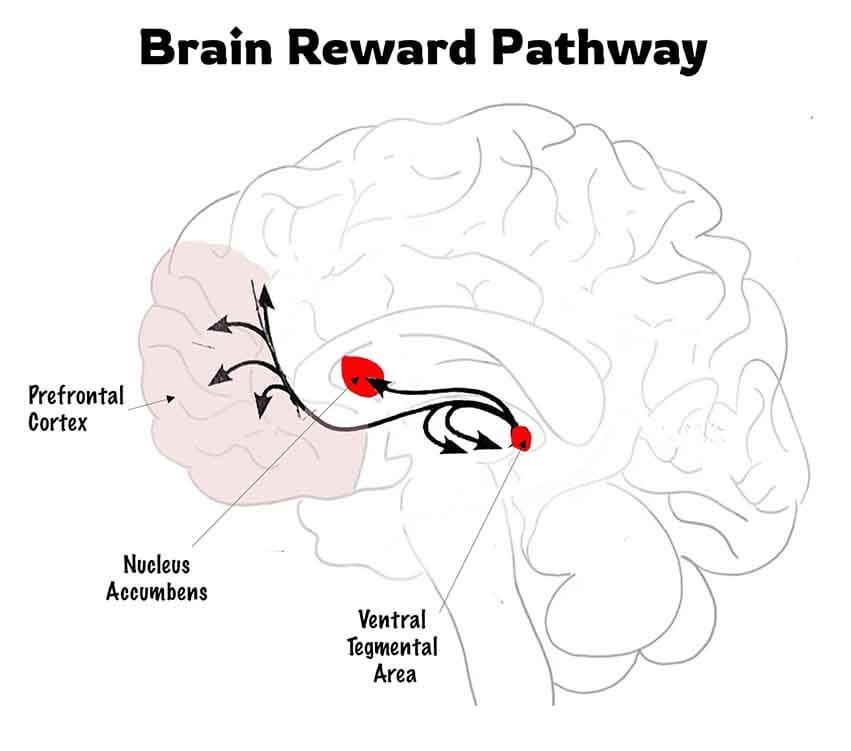
Nerves along brain pathways that process rewards (i.e., pleasure) use dopamine as a “neurotransmitter”—to deliver signals. The more dopamine an experience releases, the more we enjoy it. However, dopamine processes pain as well as pleasure, and a healthy brain maintains a balance. Most of us stop eating when we feel full. Coffee often provides all the stimulation we need. Gambling, drinking, shopping, or watching pornography are intermittent activities.
Nerves along brain pathways that process rewards (i.e., pleasure) use dopamine as a “neurotransmitter”—to deliver signals. The more dopamine an experience releases, the more we enjoy it. However, dopamine processes pain as well as pleasure, and a healthy brain maintains a balance. Most of us stop eating when we feel full. Coffee often provides all the stimulation we need. Gambling, drinking, shopping, or watching pornography are intermittent activities.
Pleasure-pain balance
A famous clinical psychiatrist and professor of psychiatry at Stanford University School of Medicine, Dr. Anna Lembke explores the biological processes behind addictive behaviors and conditions in her book “Dopamine Nation: Finding Balance in the Age of Indulgence”. Using patient anecdotes from her clinical practice, Dr. Lembke examines the significant role of the neurotransmitter dopamine in addiction.
She explains that dopamine is not governed by reason, rather pleasure-pain balance. Pleasure & pain are processed on overlapping brain regions and work via an opponent-process mechanism. Another way to say is that pleasure and pain work like a balance. Imagine our brains contains a balance – a scale with a fulcrum in the center. When nothing is on the balance, its level with the ground. When we experience pleasure, dopamine is released in our reward pathway & balance tips on the side of pleasure. The more our balance tips, the faster it tips, the more pleasure we feel.
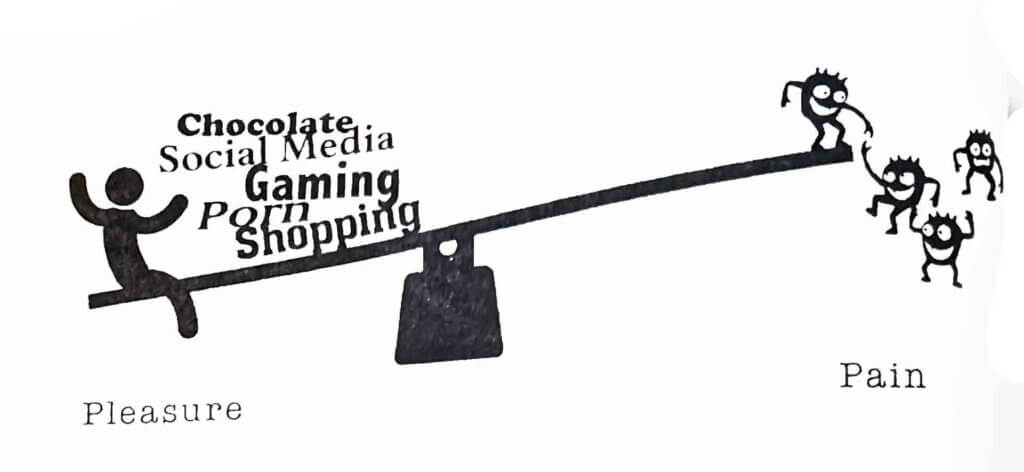
But here’s the important thing about the balance: it wants to remain level, that is, in equilibrium. It does not want to be tipped for very long to one side or another. Hence, every time the balance tips toward pleasure, powerful self-regulating mechanisms kick into action to bring it level again. These self-regulating mechanisms do not require conscious thought or an act of will. They just happen, like a reflex. Once the balance is level, it keeps going, tipping an equal and opposite amount to the side of pain.
But here’s the important thing about the balance: it wants to remain level, that is, in equilibrium. It does not want to be tipped for very long to one side or another. Hence, every time the balance tips toward pleasure, powerful self-regulating mechanisms kick into action to bring it level again. These self-regulating mechanisms do not require conscious thought or an act of will. They just happen, like a reflex. Once the balance is level, it keeps going, tipping an equal and opposite amount to the side of pain.
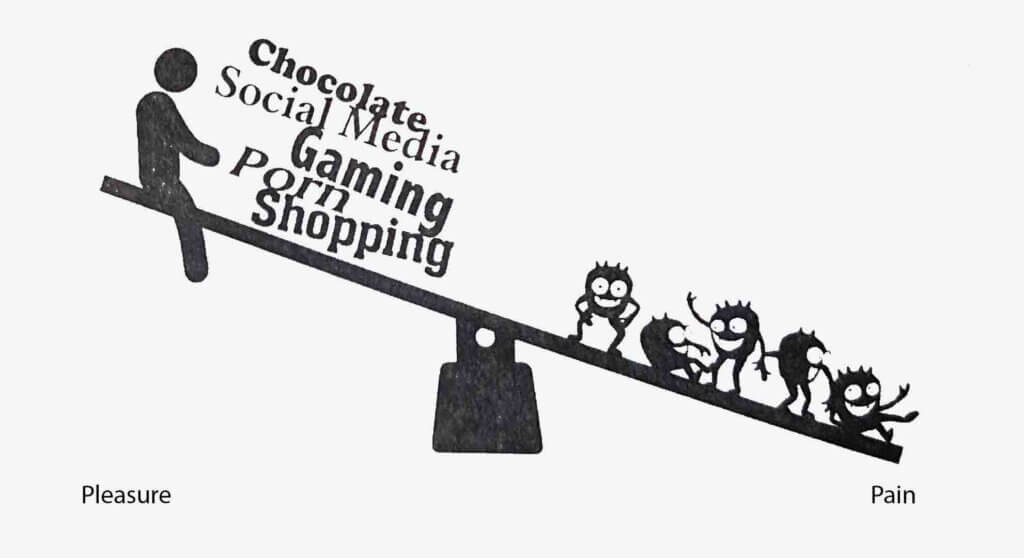
When that pleasure/pain balance tilts to the side of pain after the experience of pleasure, that pain is subjectively experienced as a number of different things. One of them is a subjective feeling of being uncomfortable, restless, irritable, unhappy and wanting to re-create the feeling of pleasure. But that’s also in many ways what craving is: wanting to have the pleasure, again, being preoccupied with eliminating the experience of pain that we feel in the aftermath.
This is when you start building the tolerance. With repeated exposure to the same and similar pleasure stimulus, the initial deviation on the side of pleasure gets weaker and shorter and the after-response to the side of pain gets stronger & longer, a process scientists call neuroadaptation. That is, with repetition, our gremlins get bigger, faster, & more numerous, and we need more of our drug of choice to get the same effect. Needing more of a substance to feel pleasure, or experiencing less pleasure at a given dose is call tolerance. Tolerance is an important factor in the development of addiction. Our hedonic (pleasure) set point changes as our capacity to experience pleasure goes down and our vulnerability to pain goes up.
Please note that the balance is only a metaphor. In real life, pleasure and pain are more complex than the workings of a balance. Pleasure and pain can occur simultaneously. e.g. one can experience both pleasure and pain when eating spicy food.
Addiction vs Habit-forming (It’s all about Anticipation & Craving)
If you can control yourself it is a habit; but if you see that the habit controls you, then it is an addiction. Habits are a result of a mental activity but addiction affects mental stability.
The measure of how addicted someone is comes down to how hard that person is willing to work to obtain its drug. The entire cycle of anticipation and craving can occur outside the threshold of conscious awareness.
When we anticipate the future reward, the balance tips to the side of pleasure, immediately followed by a tip to the side of pain (a dopamine deficit) in the aftermath of cue. This dopamine deficit is craving and drives drug-seeking behaviour.
Dopamine deficit – the Crux of habit forming products. Dopamine deficit creates the trigger-response. App makers or product developers are leveraging the basic human insight i.e. operant conditioning – where the consequences of a response to a particular trigger determine the probability of it being repeated. Dopamine release also links to the unpredictability of the reward delivery, as much as to the final reward itself. The amount of dopamine released in the reward pathway was at its highest when the probability of losing and winning was nearly identical – representing maximum uncertainty. This use of a variable reward schedule takes advantage of our dopamine-driven desire for social validation, and it optimizes the balance of negative and positive feedback signals until we’ve become habitual users. I’ve written about “variable rewards and unpredictability” in details in this link.
Can we control the pleasure-pain imbalance?
In the era marked by unparalleled wealth, freedom, and technological advancements, what is the reason for our seemingly increased unhappiness and pain?
The reason we’re all so miserable may be because we’re working so hard to avoid being miserable. This means we don’t really know what we are looking for, so we look at others to see if they have figured it out.
Although, we’ve transformed the world from a place of scarcity to a place of overwhelming abundance. Our brains are not evolved for this world of plenty. The net effect is that we now need more reward to feel pleasure, and less injury to feel pain. This recalibration is occurring not just at the level of the individual but also at the level of nations. Which invites the question – how do we survive and thrive in this new ecosystem?
We’ve all heard about digital detoxes and mindfulness practices, i.e. to stop hunting for pleasure all the time. The good thing about the brain is that there is synchronicity between different parts of the brain that has its own rhythm and breathing.
Dr. Lembke is optimistic that we can beat our digital dependencies by embracing a more monastic mindset. She advocates:
a) dopamine fasting i.e. self-binding – abstinence from the activity that releases the dopamine for certain period of time. The brain will automatically restore to homeostasis. Its easier to go from abstinence to moderation, than from excessive consumption to moderation.
b) replacing some pleasure-seeking vices with “painful” pursuits. When we do things that are challenging – going for a run, doing exercise, having an ice bath, talking to a stranger – instead of receiving a dopamine boost beforehand we experience it afterwards. Doing things that are hard is one of the best ways to pursue a life worth living, because the pleasure we get afterwards is more enduring.
Seeking oblivion vs choosing asceticism
We all desire a respite from the world – a break from the impossible standards we often set for ourselves and others. We, then, deliberately trying to escape reality, often by engaging in activities that numb the senses or provide a temporary reprieve from awareness.
What if , instead of leaving the world behind, we immerse ourselves in it? While adopting ascetic lifestyle characterized by strict self-discipline & abstention from indulgence? The goal is often spiritual enlightenment, self-realization, or a having a deeper purpose in life.
References:
“Dopamine Nation: Finding Balance in the Age of Indulgence” by Dr. Anna Lembke
sitn.hms.harvard.edu/flash/2018/dopamine-smartphones-battle-time
intellectualtakeout.org/2016/11/the-7-deadly-sins-of-social-media
theguardian.com/global/2021/aug/22/how-digital-media-turned-us-all-into-dopamine-addicts-and-what-we-can-do-to-break-the-cycle
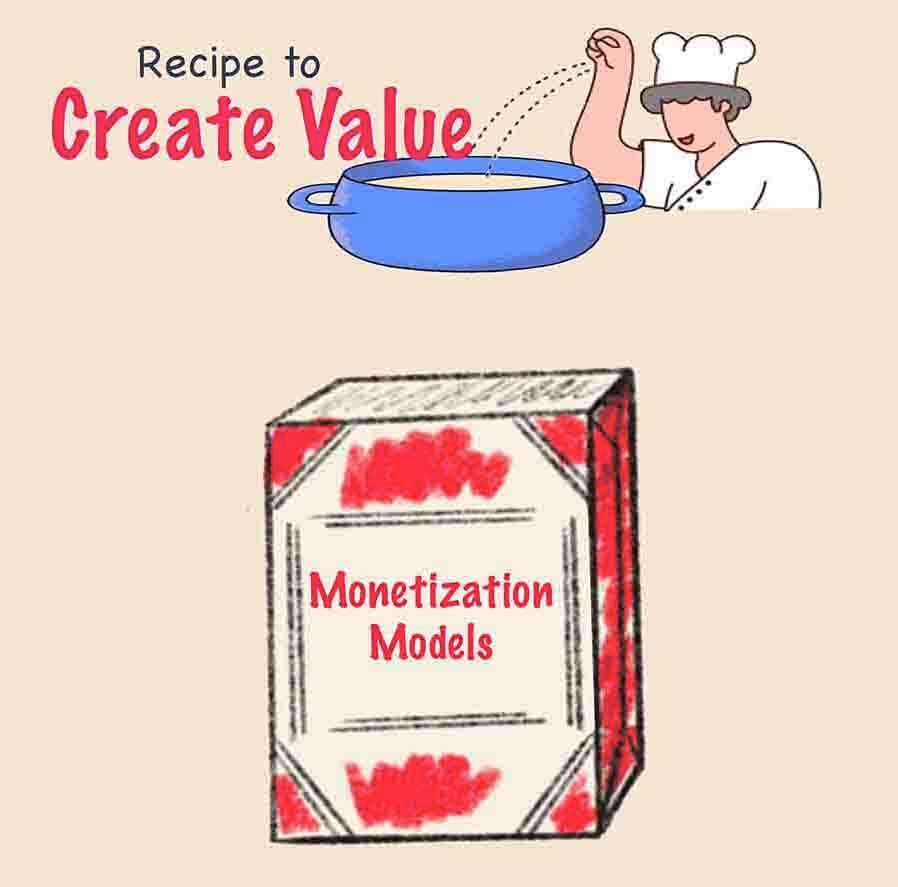
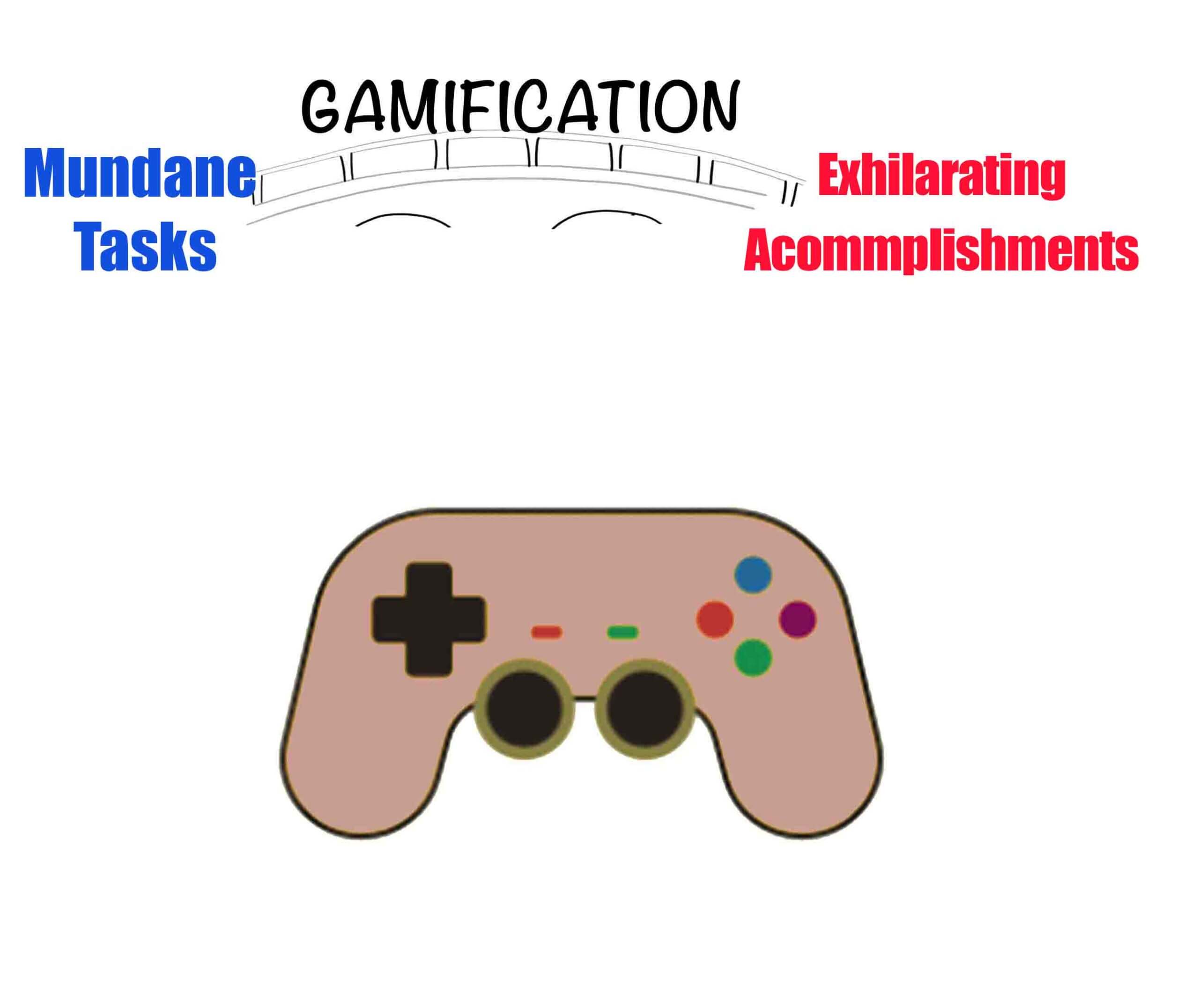
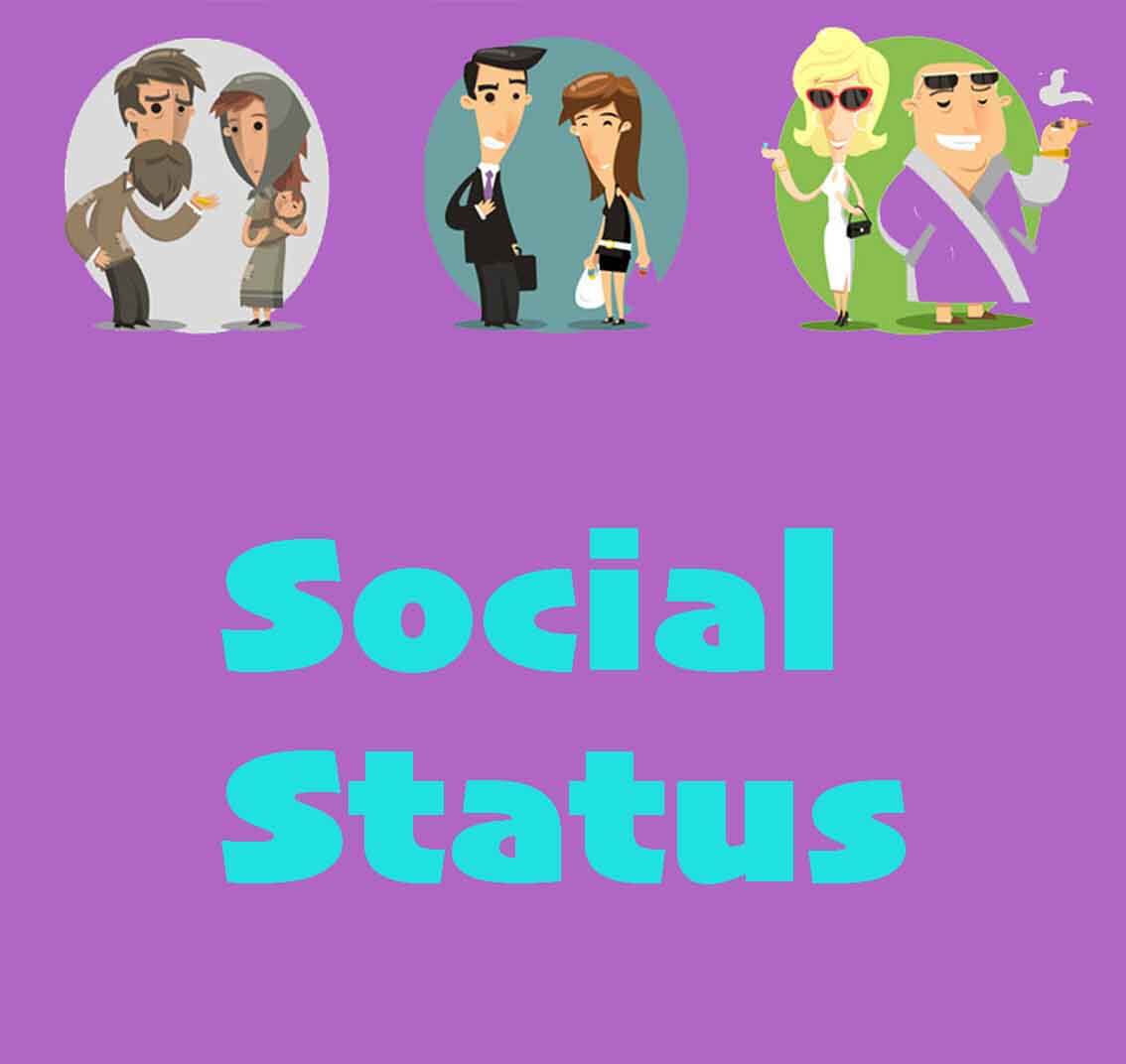
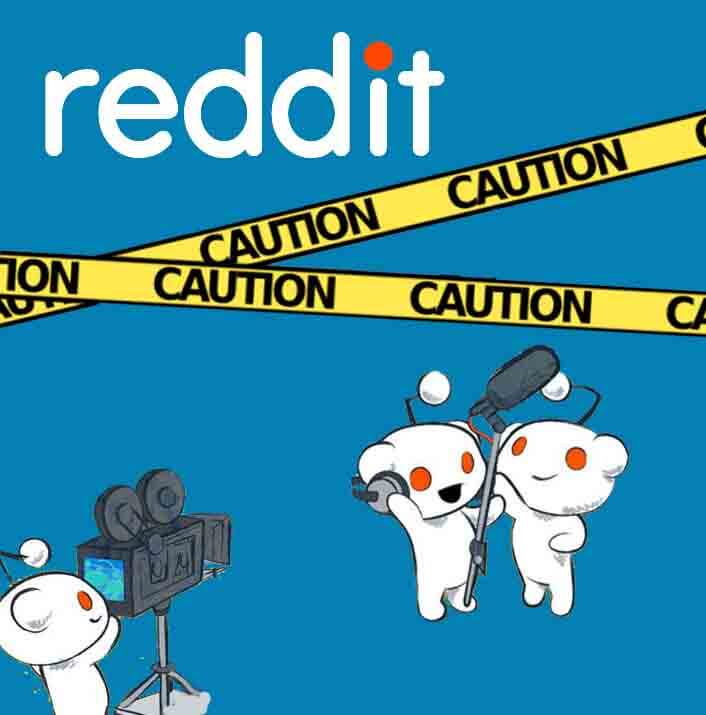
 Swipe for more stories
Swipe for more stories
Comments